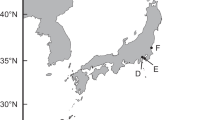Abstract
The alkaloid harman, previously reported from some marine invertebrates, was identified as the antibiotic substance of the tunicate-associated bacterium Enterococcus faecium. It exhibited antibacterial activity (MIC, 0.017 mM) against the ichthyopathogenic strain Vibrio anguillarum.
Similar content being viewed by others
References
H. Aassila A. Fassouane M.L. Bourguet-Kondracki M. Guyot (2002) ArticleTitleAntimicrobial activities of some microorganisms isolated from Moroccan Atlantic sea. Mar Life
I. Barcina J.M. Gonzalez J. Iriberri L. Egea (1990) ArticleTitleSurvival strategy of Escherichia coli and Enterococcus faecalis in illuminated fresh and marine systems. J Appl Bacteriol 68 189–198 Occurrence Handle1:STN:280:By%2BB3c3ls1c%3D Occurrence Handle2108110
A.J. Blackman D.J. Matthews C.K. Narkowicz (1987) ArticleTitleβ-Carboline alkaloids from the marine bryozoan Costaticella hastata. J Nat Prod 50 494–496 Occurrence Handle1:CAS:528:DyaL2sXltlWhsbs%3D
N.M. Carballeira F. Shalabi K. Stefanov K. Dimitrov S. Popov A. Kujumgiev S. Andreev () ArticleTitleComparison of fatty acids of the tunicate Botryllus schlosseri from the Black Sea with two associated bacterial strains. Lipids 30 677–679
P. Casteels C. Ampe F. Jacobs P. Tempst (1993) ArticleTitleFunctional and chemical characterization of Hymenoptaecin, an antibacterial polypeptide that is infection-inducible in the honeybee (Apis mellifera). J Biol Chem 268 7044–7054 Occurrence Handle1:CAS:528:DyaK3sXkvFWjtb4%3D Occurrence Handle8463238
J. Faulkner M.D. Unson C.A. Bewley (1994) ArticleTitleThe chemistry of some sponges and their symbionts. Pure Appl Chem 66 1983–1990 Occurrence Handle1:CAS:528:DyaK2cXmsFWnu7Y%3D
W. Fenical (1993) ArticleTitleChemical studies of marine bacteria: developing a new resource. Chem Rev 93 1673–1683 Occurrence Handle1:CAS:528:DyaK3sXkvFSrsb0%3D
M. Goodfellow J.A. Haynes (1984) Actinomycetes in marine sediments. L. Ortiz-Ortiz L.F. Bojalil V. Yakoleff (Eds) Biological, Biomedical, and Biomedical Aspects of Actinomycetes. Academic Press Orlando, Fla. 453–472
C. Holmström D. Rittschof S. Kjelleberg (1992) ArticleTitleInhibition of settlement by larvae of Balanus amphitrite and Ciona intestinalis by a surface-colonising marine bacterium. Appl Environ Microbiol 58 2111–2115
S. Inoue K. Okada H. Tanino H. Kakoi T. Goto (1980) ArticleTitleTrace characterization of the fluorescent substances of a dinoflagellate, Noctiluca miliaris. Chem Lett 297–298
I. Ishida H-K. Wang M. Oyama M.L. Cosentino C-Q. Hu K-H. Leu (2001) ArticleTitleAnti-AIDS agents. 46. Anti-HIV activity of harman, an anti-HIV principle from Symplocos setchuensis, and its derivatives. J. Nat. Prod. 64 958–960 Occurrence Handle10.1021/np0101189 Occurrence Handle1:CAS:528:DC%2BD3MXksFSitLg%3D Occurrence Handle11473435
P.R. Jensen W. Fenical (1994) ArticleTitleStrategies for the discovery of secondary metabolites from marine bacteria: ecological perspectives. Annu Rev Microbiol 48 559–584 Occurrence Handle10.1146/annurev.micro.48.1.559 Occurrence Handle1:CAS:528:DyaK2cXmslKht7k%3D Occurrence Handle7826019
P.R. Jensen W. Fenical (2000) Marine microorganisms and drug discovery: current status and future potential. N. Fusetani (Eds) Drugs from the Sea. Karger Basel 6–79
T.C. McKee D.L. Galinis L.K. Pannell J.H. Cardellina J. Laakso C.M. Ireland L. Murray R.J. Capon M.R. Boyd (1998) ArticleTitleThe lobatamides, novel cytotoxic macrolides from southwestern Pacific tunicates. J Org Chem 63 7805–7810 Occurrence Handle10.1021/jo980939r Occurrence Handle1:CAS:528:DyaK1cXmtlant74%3D
J. Needham M.T. Kelly M. Ishige R.J. Andersen (1994) ArticleTitleAndrimid and Moiramides A-C, metabolites produced in culture by a marine isolate of the bacterium Pseudomonas fluorescens: structure elucidation and biosynthesis. J Org Chem 59 2058–2063 Occurrence Handle1:CAS:528:DyaK2cXktVCls78%3D
R. Neu (1956) ArticleTitleCompounds contained in Passiflora incarnata, III: 3-methyl-4-carboline, the alkaloid of passionflower. Arzneimittel-Forsch 6 94–99 Occurrence Handle1:CAS:528:DyaG28XnsFCitg%3D%3D
H.C. Neu (1992) ArticleTitleThe crisis in antibiotic resistance. Science 257 1064–1073 Occurrence Handle1:CAS:528:DyaK38Xls1OhsbY%3D Occurrence Handle1509257
G. Olguin-Uribe E. Abou-Mansour A. Boulanger H. Débard C. Franscisco G. Combaut (1997) ArticleTitle6-Bromoindole-3-carbalde hyde, from an Acinetobacter sp. bacterium associated with the ascidian Stomozoa murrayi. J Chem Ecol 23 2507–2521 Occurrence Handle1:CAS:528:DyaK2sXnslGktLg%3D
M.R. Prinsep J.W. Blunt M.H.G. Munro (1991) ArticleTitleNew cytotoxic β-carboline alkaloids from the marine bryozoan Cribricellina cribraria. J Nat Prod 54 1068–1076 Occurrence Handle1:CAS:528:DyaK38XotVKltg%3D%3D Occurrence Handle1791472
H. Seki A. Hashimoto T. Hino (1993) ArticleTitleThe 1H– and 13C–nuclear magnetic resonance spectra of harman: reinvestigation of the assignments by one- and two-dimensional methods. Chem Pharm Bull 4 1169–1172
J.J. Smith J.P. Howington G.A. McFeters (1994) ArticleTitleSurvival, physiological response and recovery of enteric bacteria exposed to a polar marine environment. Appl Environ Microbiol 60 2977–2984 Occurrence Handle1:STN:280:ByuA28fhtVw%3D Occurrence Handle8085833
A.C. Stierle J.H. Cardellina II F.L. Singleton (1988) ArticleTitleA marine Micrococcus produces metabolites ascribed to the sponge Tedania ignis. Experientia 44 1021 Occurrence Handle1:CAS:528:DyaL1MXhtFWntL8%3D Occurrence Handle3197807
K. Suzumura I. Takahashi H. Matsumoto K. Nagai B. Setiawan R.M. Rantitmodjo K. Suzuki N. Nagano (1997) ArticleTitleStructural elucidation of YM-75518, a novel antifungal antibiotic isolated from Pseudomonas sp. Q38009. Tetrahedron Lett 38 7573–7576 Occurrence Handle10.1016/S0040-4039(97)01785-1 Occurrence Handle1:CAS:528:DyaK2sXntVKhtbo%3D
J.E. Thompson R.P. Walker D.J. Faulkner (1985) ArticleTitleScreening and bioassays for biologically-active substances from forty sponge species from San Diego, California. Mar Biol 88 11–21 Occurrence Handle1:CAS:528:DyaL2MXmtFWmt70%3D
M.D. Unson D.J. Faulkner (1993) ArticleTitleCyanobacterial symbiont biosynthesis of chlorinated metabolites from Dysidea herbacea. Experientia 49 349–353 Occurrence Handle1:CAS:528:DyaK3sXltlGitbk%3D
M.D. Unson N.D. Holland D.J. Faulkner (1994) ArticleTitleA brominated secondary metabolite biosynthesised by Cyanobacterial symbiont of marine sponge and accumulation of the crystalline metabolite in the sponge tissue. J Mar Biol 119 1–11 Occurrence Handle1:CAS:528:DyaK2cXmtVSmsrs%3D
D.H. Welti (1985) ArticleTitleRevision of the signal assignment of harman on one- and two-dimensional inadequate spectroscopy. Mag Res Chem 23 872–874 Occurrence Handle1:CAS:528:DyaL28Xhs1ylt7g%3D
Acknowledgements
We thank F. Monniot for identification of the tunicate; J.P. Brouard and N. Morin for low and high resolution mass spectra, respectively; G. Gastine for antibacterial tests; and J.L. Nicolas (Ifremer, Brest) for providing Vibrio strains. This work was supported by the International Foundation of Science (IFS) with grant N:F 2401-2 to A.F.
Author information
Authors and Affiliations
Corresponding author
Rights and permissions
About this article
Cite this article
Aassila, H., Bourguet-Kondracki, M., Rifai, S. et al. Identification of Harman as the Antibiotic Compound Produced by a Tunicate-Associated Bacterium . Mar. Biotechnol. 5, 163–166 (2003). https://doi.org/10.1007/s10126-002-0060-7
Received:
Accepted:
Issue Date:
DOI: https://doi.org/10.1007/s10126-002-0060-7




